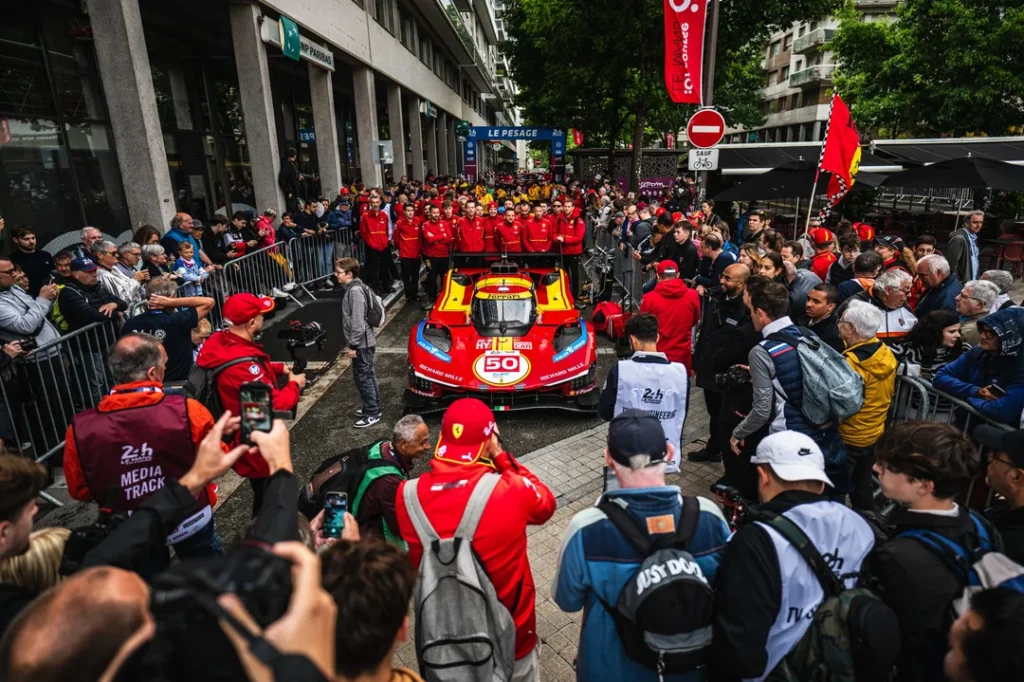
The 2025 edition of the 24 Hours of Le Mans perfectly embodies why this race remains the heart of global motorsport. While Formula 1 continues expanding its calendar, endurance racing quietly delivers a superior experience for both fans and competitors, with deeper access, better on-track action, and an unmatched connection between drivers, teams, and spectators.
Nowhere is that spirit more evident than during scrutineering, the ceremonial technical inspection held right in the city center. It’s one of the most unique motorsport traditions in the world: cars are pushed through the town square while fans gather feet away from the drivers, engineers, and Hypercars themselves. This isn’t a closed-off paddock or fenced garage, it’s open, intimate, and integrated into the very streets of Le Mans.
For attendees, the Le Mans experience dwarfs that of Formula 1. Here, you’re not limited to grandstand seating or staring at trackside jumbotrons. Spectators walk the circuit’s varied viewing points throughout the 24 hours, camp alongside the track, and feel part of the race’s living history. The cost of access remains reasonable, the atmosphere electric, and the connection to the event far more personal than any modern F1 weekend.
Beyond its traditions, the competitive landscape at Le Mans has entered a true renaissance. The Hypercar grid for 2025 is already stacked, Toyota, Ferrari, Porsche, Peugeot, Cadillac, Alpine, BMW, but this is only the beginning. Over the next two years, McLaren will return as a full factory Hypercar entrant, Genesis is building its own prototype program, Ford is launching a Hypercar campaign, and even Acura may soon join, pending internal agreements within Honda’s corporate structure.
The variety of machinery is staggering, and visually, Hypercars have reached a design language that captures the imagination. These cars resemble futuristic machines pulled straight out of old Ridge Racer video games, brutal, aggressive, and alien in a way modern F1 cars simply aren’t. If Formula 1 wasn’t so bound to tradition, this is likely what its cars would look like today. Hypercars blend advanced hybrid systems with dramatic styling, while manufacturers continue to explore cutting-edge technologies like hydrogen-powered engines for the future.
Yet while the grid grows, corporate complexities remain. Acura’s entry still hinges on delicate negotiations between American Honda Motor and the parent Honda organization. Historically, these divisions have operated under a non-interference agreement that limited Acura’s racing programs to North America. Recent consolidation under Honda Racing Corporation (HRC) suggests potential change, but for now, Acura remains on the sidelines of WEC competition.
This Hypercar boom comes alongside a broader realization: for many fans, sports car racing simply delivers better on-track action than Formula 1. Endurance races offer hours of wheel-to-wheel battles across multiple classes, where every stint can reshape the story. The 8 Hours of Spa remains one of the most thrilling races of the modern era, while lower-tier series like GT3 regularly outshine F1 in pure racing spectacle. Every moment at Le Mans carries consequence, with fewer parade laps and far more dynamic lead changes than the average Grand Prix.
One of the standout stories in 2025 is the extraordinary number of former Formula 1 drivers now competing at Le Mans. Seventeen ex-F1 drivers are spread across the Hypercar class alone, adding a deep well of top-tier experience to the grid. Familiar names include Jenson Button, Sebastian Buemi, Kamui Kobayashi, Kevin Magnussen, Robert Kubica, Nyck de Vries, Stoffel Vandoorne, Pascal Wehrlein, and Mick Schumacher, among others. Some — like Buemi, Hartley, and Kobayashi — are already multiple-time Le Mans winners; others, such as Schumacher, Magnussen, and Button, are seeking to add endurance success to their Formula 1 legacies.
In LMP2, that F1 pedigree continues, with drivers like Pietro Fittipaldi and André Lotterer bringing further Grand Prix experience to the field. Lotterer’s case is particularly symbolic of the crossover nature of endurance racing: after just a single Grand Prix start for Caterham in 2014, he pivoted to a highly successful career in sports cars and Formula E, ultimately becoming one of the most respected endurance specialists of his generation.
In every aspect, competition, technology, affordability, fan access, and culture, Le Mans continues to solidify itself as the most complete motorsports event in the world. While Formula 1 remains technologically brilliant, its race experience often comes with enormous crowds, high costs, limited viewing, and static race formats that struggle to match the drama of multi-class endurance racing.
The 2025 Le Mans isn’t just another weekend. It represents the convergence of tradition and evolution, a race that maintains its grassroots connection to fans while pushing the boundaries of engineering. As the Hypercar era matures, and with more manufacturers committing to join, endurance racing is not only alive and well, it may very well be entering its most exciting decade yet.
